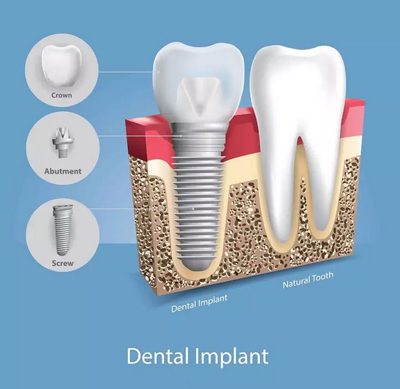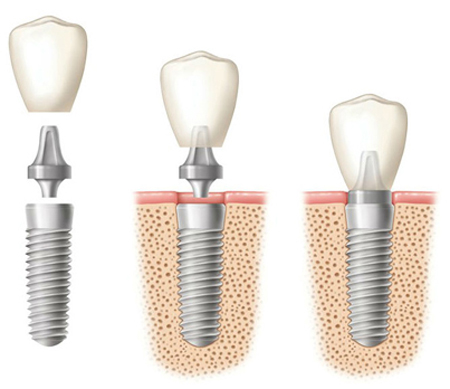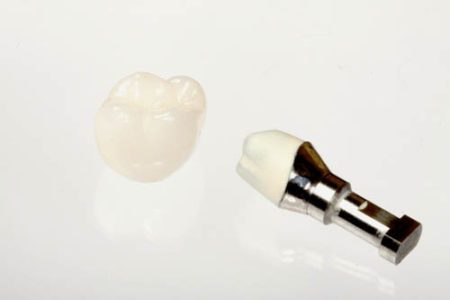I Still Have Two Baby Teeth
On the upper left side of my mouth, the incisor and canine teeth are still the baby teeth, even though I am 28 years old. The missing adult teeth never grew in. My smile really looks funny because the two teeth are very noticeable. I don’t want porcelain crowns or veneers. Is it possible to remove the teeth and replace them with implants? – Thank you. Karson from Lincoln, NE
Karson,
Thank you for your question.
If You Still Have Baby Teeth Will Dental Implants Work?

If you still have two baby teeth, dental implants can replace them if there are no impacted permanent teeth beneath the primary teeth. In many cases, the permanent teeth are impacted. You cannot replace the teeth with dental implants until a dentist takes x-rays to locate the permanent teeth. Afterward, the dentist will determine your treatment options.
Your dentist may refer you to an orthodontist who can help impacted teeth erupt into the correct position. It is common for lateral incisors, premolars, and wisdom teeth not to form. The orthodontist may open your gum tissue to expose each tooth. If the teeth need assistance emerging into the correct position, braces can guide them.
An orthodontist will determine whether there is enough room for each tooth to erupt or if they must reposition or remove any teeth to help impacted teeth emerge. Dental implants may be an option for underdeveloped or malformed impacted teeth.
Moline, Illinois dentist, Dr. Thomas Goebel, sponsors this post.
How Long Can I Delay Root Canal or Tooth Removal?
A crown on my upper left first molar broke. My dentist said that the tooth had died, and if he could not remove all the decay, he would refer me to an oral surgeon to remove the tooth. Then, he would place a dental bridge. I asked my dentist to refer me to an endodontist, and I have an appointment in two weeks. I read online that a dental implant is better than a bridge. Is there any reason I should have the tooth removed right away? How long can I wait before this becomes a bigger problem? – Thank you. Selina from Allegheny, PA
Selina,
Thank you for your question. Dr. Goebel would need to examine your teeth and x-rays. But we can offer some insight.
Removing vs. Saving a Tooth

If a tooth is healthy enough to save and will not negatively affect your oral health, it is best to save it. Although dental implants are a highly effective tooth replacement, healthy natural teeth are better. We recommend that you keep your appointment with the endodontist (root canal specialist) for a second opinion.
How Long Can You Wait Before a Root Canal?
You did not mention if your tooth hurts, but the specialist will need to check for the extent of the infection. Without treatment, infection will continue to spread. So, the condition of your teeth and your oral health will continue to decline without root canal treatment.
Also, if the tooth requires removal, leaving the space without a dental implant will allow other teeth to drift into the area. Tooth misalignment can lead to other issues like jaw pain or the need for orthodontic treatment.
Get a Second Opinion
Your dentist seems uncomfortable replacing your tooth with a dental implant and crown. Even if your dentist would refer you to an oral surgeon for implant placement, we are concerned about his experience with implant crowns and crowns in general. After your appointment with the root canal specialist, we recommend scheduling an appointment with an experienced dentist to discuss your options after root canal treatment or extraction.
Moline, Illinois dentist, Dr. Thomas Goebel, sponsors this post.
Which Implant and Crown Brands Should I Ask My Dentist to Use?
I am searching for a cosmetic dentist because I need extensive work done. So far, I have had two consultations. One dentist recommended ten implants for upper teeth. The other dentist wants to do a CT scan before defining her treatment plan. I have a few questions about some of the research I have done.
- Are Astra implants from the UK a quality brand?
- Is there anything a top cosmetic dentist can do to give Cercon® smart zirconia crowns a more natural look? I have read that they are as strong as PFM (porcelain fused to metal) crowns.
- Is it true that white or gold metal is a good foundation for a crown and will not make my gum line dark?
- What looks better, zirconium or white abutments for dental implants?
Thanks for your help. I cannot seem to find the answers to those four questions. If the solutions are online, maybe I do not understand the technical terminology.
Thanks. Roman from Seattle
Roman,
Our recommendation for any cosmetic dentistry patient is to focus on the dental artist instead of the dental materials. If you try to decide what is best for your smile, you will be directing your dentist. And that is not the right approach. Try to put yourself in the dentist’s position.
Reasons Not to Dictate to Your Cosmetic Dentist
Suppose you are an artist contracted to paint original works for a high-end corporate building. You consult with the building manager, who is not an artist, to find out what type of paintings she would like in the hallways. She gives you the information you need about the type of artwork to create, but she also gives you the following list:
- Types, brands, and sizes of brushes
- Paint brands and where to buy them
- Which stool to use as you paint the pictures
- The exact color palette for each painting
Although your signature will be on the paintings, the building manager’s list might negatively influence the results. Her micromanagement disregards your artistic talent and choice of materials, some of which are brands you prefer not to use. Her preferences make you uncomfortable.
An advanced cosmetic dentist is an artist with extensive training and experience in aesthetic dentistry. They know the factors that influence the health and beauty of your smile, including:
- Materials – Knowledge of the pros and cons of dental materials, their mechanics, and if they will work for your case
- Manufacturers – Ability to evaluate their claims about dental materials, products, and devices, and confirm that research supports the claims
- Clinical use – Understanding how materials, tools, or parts will function in an actual patient case
- Technique – Ability to predict how an element or component will work in the dentist’s hands based on their skill and experience
Which Metal-Based Crowns Will Not Show Through Your Gumline?
Neither porcelain-fused-to-white-metal nor porcelain-fused-to-gold crowns will prevent a dark line at the gumline. Consider a few facts:
- The color of every metal used in porcelain-fused-to-metal (PFM) crown is either white or gold.
- A dark line at the gumline is the cement line.
- When cosmetic dentists combine bonding techniques with pure ceramic—not metal color—it eliminates darkness at the gumline.
- Another method to minimize the dark line is for the dental ceramist to cut back the metal at the margin and replace it with porcelain.
Zirconium

Zirconium oxide is an opaque white, but a ceramist can cover it with a translucent ceramic. You will have an extraordinarily strong crown that looks natural.
Choose an accredited cosmetic dentist who is experienced in implant dentistry, too. They will consider your case and choose high-quality materials that function well and look natural.
Dr. Thomas Goebel, a Moline, Illinois dentist, sponsors this post.
Why Can’t the Dentist Find the Source of My Toothache?

Thomas,
Thank you for your question.
Pain in your tooth can originate with an infection in the tooth, or with an infection in your gums. If an infection is both in your tooth and your gums, it would make it difficult for the emergency dentist to make that determination.
What Causes a Toothache?
- Root canal infection – An infection in the root canal of a tooth can spread into the bone and tissue around the tooth, which help to support and stabilize the tooth. With a history of the progression of your pain, along with x-rays, a dentist can determine that the problem started in your tooth and spread to your gums and jawbone.
- Gum infection – Another possibility is an infection that starts in the gums and spreads to the tooth. An advanced gum infection can spread into the tooth roots and up into the pulp of the tooth, causing a very painful toothache.
- Gum and tooth infection – It is possible that both your gums and tooth are infected. If that’s the case, a dentist needs to carefully review the history of your toothache, take an x-ray of the tooth, and test the sensitivity of your tooth to pressure and temperature. Another dentist may be thorough enough to determine the cause of your pain. Otherwise, you may have to see an endodontist (root canal specialist) or a periodontist (specialist in the gums and supporting structure of the teeth).
The infection will continue to spread until it is treated, so please do not delay treatment. An experienced dentist can save the tooth and prevent the need for an extraction and implant.
Dr. Thomas Goebel, a Moline cosmetic dentist, sponsors this post.
Dental Implant Delayed Due to a Sinus Infection
Can you tell me why my dentist can’t clear my sinus infection after tooth extraction? This issue prevents me from getting a dental implant. After removing my upper left tooth, my dentist prescribed clindamycin antibiotics for a week, but the infection isn’t gone. I finished the antibiotics, but I still feel pressure in my face and nose. I have tried nose spray and decongestant. Before I call the office back, can you give me an idea of what my dentist should recommend?
Also, if his recommendation does not match yours, should I ask for another round of clindamycin? Is this a routine problem that my dentist should have known about? I am afraid it will not heal, and I cannot get an implant. Thank you. Jeremiah from Columbia, SC
Jeremiah,
Dr. Goebel would need to examine your tooth and review your x-ray for an accurate diagnosis. But from your description, your dentist is not negligent.
Upper molar tooth roots are often located close to the sinus. So, when your dentist removes a tooth, the sinus can rupture. Sometimes only a thin membrane separates tooth roots and the sinus.
A dentist may treat the issue with these steps:
- Close the perforation
- Use a surgical gelatin sponge or bone grafting if you need a dental implant
- Stich the opening closed
- Prescribed antibiotics if you have an infection
After finishing antibiotics, contact your dentist if the infection does not clear. Although you may need another course of antibiotics, your dentist may need to switch you from clindamycin. Sometimes bacteria become antibiotic resistant.

Afterward, if the infection persists, your dentist may need to refer you to an otolaryngologist (or ear, nose, and throat specialist). The specialist will coordinate your care with your dentist to ensure the infection is gone before dental implant surgery.
You can expect about four months of bone graft healing before you get a dental implant. And after implant surgery, it takes three to four months for your jawbone and implant to fuse. Then, your dentist can complete the implant with a dental crown.
Cosmetic dentist Thomas J. Goebel, DDS of Moline, Illinois, sponsors this post.
Are My Dental Crowns Too Short?
crowns. The implant crowns are on my top left first and second molars, but they do not touch the bottom first and second molars when I bite down. My dentist checked my bite when he placed the crown, and he knows the teeth do not meet. I thought that top and bottom teeth should slightly meet when you bite down or chew. Are my implant crowns too short? – Thank you. Cecilia from Detroit
Cecilia,
Dr. Goebel would need to examine your teeth and implant crowns to determine whether the crowns are too short or if another issue is affecting your bite. But yes, your upper and lower teeth should touch when you bite down or chew. To achieve a proper bite, a dentist needs advanced training in occlusion (how your teeth come together).
Should Your Upper and Lower Teeth Touch?
Your upper and lower teeth should touch when your mouth is closed and when you bite down for several reasons:
- Jaw function – When you clench your teeth together, all your teeth will meet at the same time if your bite is aligned correctly.
- Sliding function – When you move your teeth from one side to another, either only your canine teeth should touch, or all your back teeth should touch evenly.
Without proper occlusion (how your teeth meet), your teeth may move over time and become crowded. Also, a misaligned bite can cause jaw and neck pain, headaches, and ringing in our ears.

Some dentists check your bite with this method:
- Put a 0.05 mm thin strip of plastic between your teeth
- Ask you to clench your teeth together
- Pull the strip to see if your teeth can hold it or if it is easy to release
If your teeth meet correctly, they will hold onto the strip.
Ask your dentist to recheck your bite to ensure your implant crowns fit well. If your dentist cannot resolve the issue, schedule a consultation with a dentist with advanced training in occlusion and bite.
Cosmetic dentist Thomas J. Goebel, DDS of Moline, Illinois, sponsors this post.
My Implant Crown Is Still the Wrong Color
After two tries, my dentist could not get the color right on my implant crown. He had me visit the lab to check the crown color. Both times, when the crown was ready, my dentist was hasty in attaching it. I cannot see well in his office. And in retrospect, I should have gone outside to look at my crown. It is still the wrong color. My current peak hurts, too. My dentist had difficulty getting it onto the implant, so I avoid chewing on the left side of my mouth. Although my dentist thinks I need time to adjust to the crown, I’m done with him. Still, I am a little nervous about finding another dentist and getting a new implant crown. Can I ask for a refund? Thanks. Dmitriy
Dmitriy,
We are sorry that you have a frustrating experience with your implant crown. Replacing a missing tooth with an implant should give you natural-looking results so that you cannot tell the difference between the implant and your natural teeth. That is one reason people choose implants.
When a Dentist Cannot Match Your Implant Crown to Your Teeth

Get a Second Opinion
You are wise to get a second opinion for replacing your implant crown. This time, look for a dentist with advanced training in cosmetic dentistry and restoring dental implants. You can expect the following:
- Achieve a perfect color match for your crown
- Replace the crown without damaging your implant
- Ensure the implant crown fits well and is in harmony with your bite
You can begin by scheduling consultations with at least two implant dentists with advanced cosmetic dentistry training. After the consultation, you can choose a dentist. And yes, ask your dentist for a refund because he did not give you a functioning crown that matches your natural teeth. Your new dentist may be willing to help you request a refund.
Cosmetic dentist, Thomas J. Goebel, DDS of Moline, Illinois, sponsors this post.
My Front Tooth Implant Makes My Gums Uneven
After getting an implant for my left front tooth, the gumline is still higher than my other teeth. My dentist said that the temporary crown would give my gumline a chance to settle, but it has been almost three months, and the unevenness makes my $5,400 implant look fake. Is this issue likely to resolve on its own? – Thanks, Jon from Allentown, PA
Jon,
Thank you for your question.
Before dental implant surgery, a dentist or oral surgeon must determine the optimal position for your implant so that it looks like it is coming out of your gums—not sitting on your gumline.
Sometimes a temporary implant crown allows the gum to grow down to the crown. But if it has been almost three months and you do not see any improvement, your dentist needs to intervene.
Especially if your gumline shows when you smile, you want it to be even with the rest of your teeth. You can insist that your dentist corrects the issue while you are wearing the temporary crown. Otherwise, your final implant crown may not look any better.
What to Do About an Uneven Gumline After Dental implants

If your gumline is uneven after dental implants, it could require additional surgery. If you have enough gum tissue above the implants, a dentist or periodontist can stretch and secure it over the edge of your dental crown. Otherwise, a dentist can take gum tissue from the roof of your mouth,
If your dentist is not skilled with gum grafting or contouring, you can look for a dentist with advanced cosmetic dentistry training to complete the work. Consider scheduling a second opinion with a skilled cosmetic dentist to discuss your options. You will get natural-looking results that help your dental implant blend with your natural teeth.
Thomas J. Goebel, DDS, of Moline, IL, sponsors this post.
How many times can my dentist replace my implant crown?
How many times can my dentist replace my implant crown without causing implant failure? My dentist says that getting the color right on my implant crowns is challenging. She said that after changing the crowns twice, I should be happy that the implants are still stable. Am I at risk for dental implant failure? I am concerned about my investment and my health. Thanks for your help. Jael from Chicago
Jael
We are sorry that you are having this experience with your dentist. We will explain the process and how you can find a dentist to match your crowns correctly. However, Dr. Goebel would need to examine your implant crowns for accurate diagnosis and treatment options.
Removing Implant Crowns Safely
A skilled dentist knows which tools to use to remove an implant crown without damaging the implant and risking failure.
Matching Implant Crowns
Without advanced cosmetic dentistry training, matching implant crowns is a challenge. Therefore, your dentist is unable to achieve natural-looking results.
Even a skilled cosmetic dentist must patiently achieve a perfect match. But cosmetic dentists who understand color matching take these steps:
- Try-in crowns at least three times to ensure a match
- Draw a color map for the ceramist
- Specify a basic shade in the written instructions
- Draw areas where the ceramist should add tints to match your natural tooth color
- Use high-quality, digital photographs to take pictures of the try-in
- Look for areas that need color adjustment and send details to the ceramist
- Avoid cementing the crown unless the color match is perfect

A general or family dentist is unlikely to go beyond finding a close match. They are often satisfied with making your crown look acceptable next to your natural teeth.
Schedule a Consultation with a Cosmetic Dentist
A cosmetic dentist will take time to ensure the variations of tooth color and translucence in your natural teeth are replicated in your implant crown. Look for at least two advanced cosmetic dentists in your area and schedule consultations.
Thomas J. Goebel, DDS, of Moline, Illinois, sponsors this post.
What is this weird sensation I feel with my new dental crown?

Darren,
When a dentist places your crown correctly, it should feel like a healthy natural tooth. You not notice that you have a crown. Sometimes, even bite adjustments are not enough to resolve the discomfort because the problem lies beneath the crown.
Uncomfortable New Dental Crown
If discomfort in your crown lingers, get a second opinion, and ask for an x-ray. Sometimes, decay beneath a crown can cause lingering discomfort. If the problem tooth previously had root canal treatment, you would not feel pain or have a toothache. Your symptoms might be vague and difficult to describe.
What Causes Tooth Decay Beneath Crowns?
Tooth decay beneath a crown can occur in these instances:
- Bacteria or plaque gets trapped beneath the crown
- Root canal failure
- Lingering decay or infection that a dentist covers with a crown
Depending on the condition of your tooth and how much tooth structure is left, the second opinion dentist may recommend
- Adjusting the crown
- Remaking the crown
- Extraction, replacing the tooth with a dental implant, a new implant crown
After retreatment, your tooth and bite should be comfortable.
Thomas J. Goebel, DDS, of Moline, IL, sponsors this post.
